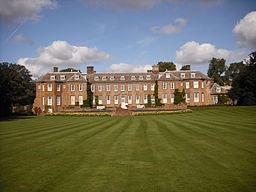Upton House, Warwickshire
| Upton House | |
| stately home | |
|
The South Terrace
|
|
| Country | England |
|---|---|
| State | Warwickshire |
| Region | Midlands |
| District | Warwickshire |
| Municipality | Warwick |
| Founded | Built c.1695 |
| Owner | in the care of the National Trust |
| Visitation | accessible to the public with a fee (All year round) |
| Website: Upton House at the National Trust | |
Upton House is a country house in the civil parish of Ratley and Upton, in the English county of Warwickshire, about 7 miles (11 km) northwest of Banbury, Oxfordshire. It is in the care of the National Trust.
The house was built on the site of the hamlet of Upton, which was destroyed in about 1500 when the land was cleared for pasture. The estate passed through various hands until the early 16th century when it was bought by Sir William Danvers. It remained with the Danvers family until 1688 when Sir Rushout Cullen purchased the estate for £7,000 (equivalent to £1,140,000 in 2015). Cullen built the house for himself in about 1695.
In 1757 the house was bought by banker Francis Child for use as a hunting lodge and it remained in the Jersey family until the end of the 19th century when it was held by George Child Villiers, 5th Earl of Jersey. In 1927 the estate was acquired by Walter Samuel, 2nd Viscount Bearsted, who owed his fortune to the fact that his father Marcus Samuel was the founder of the oil company Shell Transport & Trading. Lord Bearsted donated the house, gardens and art collection to the National Trust in 1948.
Lord Bearsted's son, the 3rd Viscount, lived at Upton from 1948 until his death in 1986 and added to the gift to the National Trust the collection of fine porcelain. On the death of the 3rd Viscount, the furniture and other items on view in the rooms were offered to the nation by his daughter, Hon. Mrs. R. Waley-Cohen, through the "in lieu" system, on condition that they remain at Upton and on view to the public.
Mrs. Waley-Cohen continued to live in the house until 1988, when the family moved to another property on the estate. In October 1991, she offered for sale by public auction, a large number of items which were considered surplus to requirements. The sale at the house by Christie's, in a total of 1083 separate lots, included pictures, furniture, porcelain, silver, objects and carpets.
...
Wikipedia

